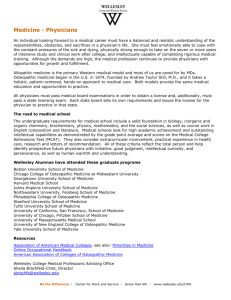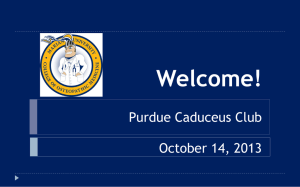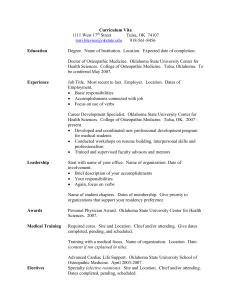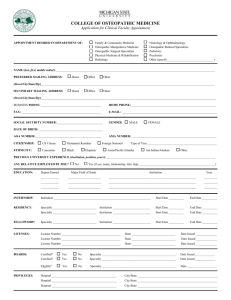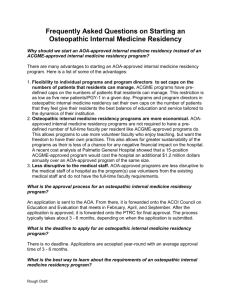Comments from specialty colleges on ACGME policies
advertisement
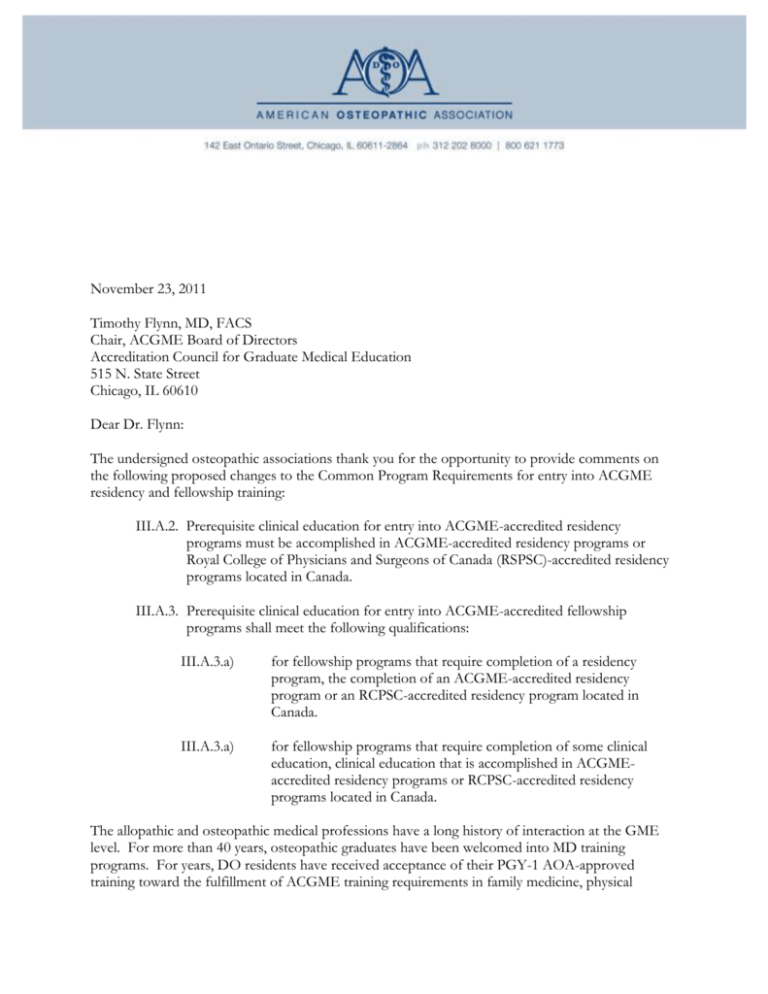
November 23, 2011 Timothy Flynn, MD, FACS Chair, ACGME Board of Directors Accreditation Council for Graduate Medical Education 515 N. State Street Chicago, IL 60610 Dear Dr. Flynn: The undersigned osteopathic associations thank you for the opportunity to provide comments on the following proposed changes to the Common Program Requirements for entry into ACGME residency and fellowship training: III.A.2. Prerequisite clinical education for entry into ACGME-accredited residency programs must be accomplished in ACGME-accredited residency programs or Royal College of Physicians and Surgeons of Canada (RSPSC)-accredited residency programs located in Canada. III.A.3. Prerequisite clinical education for entry into ACGME-accredited fellowship programs shall meet the following qualifications: III.A.3.a) for fellowship programs that require completion of a residency program, the completion of an ACGME-accredited residency program or an RCPSC-accredited residency program located in Canada. III.A.3.a) for fellowship programs that require completion of some clinical education, clinical education that is accomplished in ACGMEaccredited residency programs or RCPSC-accredited residency programs located in Canada. The allopathic and osteopathic medical professions have a long history of interaction at the GME level. For more than 40 years, osteopathic graduates have been welcomed into MD training programs. For years, DO residents have received acceptance of their PGY-1 AOA-approved training toward the fulfillment of ACGME training requirements in family medicine, physical Timothy Flynn, MD, FACS 11/23/11 Page 2 medicine and rehabilitation, radiology, and anesthesiology. Many of our graduates who enter ACGME-accredited programs are attracted to the breadth and geographic diversity that ACGME programs offer. Osteopathic training is equivalent to allopathic training, with DOs possessing additional skills in osteopathic manipulative medicine and knowledge of osteopathic principles and practices. The osteopathic core competencies in postdoctoral training are the following: 1. 2. 3. 4. 5. 6. 7. Osteopathic Philosophy and Osteopathic Manipulative Medicine Medical Knowledge Patient Care Interpersonal and Communication Skills Professionalism Practice-Based Learning and Improvement Systems-Based Practice These core competencies, similar to the ACGME core competencies, are the foundation for osteopathic postdoctoral training. The proposed Common Program Requirements place barriers on the resident selection process without credible research evidence to support the restriction. While hundreds of osteopathic physicians have transferred to ACGME programs after their initial years of training and others have advanced to fellowship training from AOA base residency programs, we are not aware of any evidence of inadequate training within osteopathic medical programs. In fact, evidence suggests otherwise. ACGME program directors continue to seek out residents and fellows from AOAapproved training programs. The proposed policies are an anathema to the established recognition of osteopathic medicine by other entities. While the proposed policies halt recognition of osteopathic residency training, AOAapproved training is recognized by state licensing boards as satisfying requirements for postdoctoral education, by the CMS for funding GME, and by all branches of the military medical corps, the Veterans Administration, and the U.S. Public Health Service. Similarly, osteopathic physicians who complete AOA training are eligible for membership and fellowship in professional organizations like the American Academy of Family Physicians and the American College of Surgeons, to name a few. Hospitals and medical centers throughout the United States have completed comprehensive reviews of the AOA residency training requirements and recognize them as equivalent for purposes of credentials and privileges. Recognizing the quality of osteopathic residency training, many hospitals and hospital systems include both AOA- and ACGME-accredited training programs. The proposed policies do not increase the quality of care and, in fact, have the potential to reduce quality. Program directors well know the attributes, knowledge, and skills of successful residents in their programs. By restricting who a program director may select, the quality of patient care may be harmed. Again, there is no evidence that osteopathic medical residents have inadequate training. The proposed policies may increase the cost of GME. The resources to support GME are scarce and unlikely to increase. Most of the current GME funding is provided by taxpayers through CMS. The AOA believes that limited public resources for GME should be deployed efficiently for the public benefit. Forcing physicians who have already completed one or more years of AOA- Timothy Flynn, MD, FACS 11/23/11 Page 3 approved osteopathic residency training to repeat a first year of training is not an appropriate use of resources, when the same funds could be used to pay for another physician’s graduate training. Despite the proposed implementation date, the proposed requirements are already affecting students, residents, faculty members, and program directors. We are hearing reports that ACGME program directors are declining meetings with potential and current DO student and resident applicants. These circumstances have the potential to significantly disrupt DO students’/residents’ planned career pathways. We are interested in cooperating with the ACGME to produce a better GME system. The osteopathic system has its own initiatives to improve quality. For more than a decade, the AOA has hosted the Web-based Clinical Assessment Program to evaluate the care provided in family practice and internal medicine residency programs. The AOA has instituted requirements for uniform residency standards and a triennial review of those standards. The Osteopathic Postdoctoral Training Institutions (OPTIs) provide a mechanism to provide osteopathic manipulative training and research resources. The AOA certifying boards undergo a triennial evaluation to ensure their examinations meet and exceed rigorous uniform psychometric standards. The osteopathic community embraces quality and has credible accreditation and certification processes to support our quality efforts. In addition, it is important for you to note that all osteopathic physicians entering AOA or ACGME training completed four years of osteopathic medical school in the U.S. The AOA does not accept any foreign medical graduates into its postdoctoral training programs without completing its osteopathic medical school curriculum. It is imperative that the ACGME’s proposed Common Program Requirements on entry into ACGME accredited training programs be withdrawn in order to ensure the continued efficient training of our nation’s physician workforce. If the proposed policy cannot be withdrawn, we recommend it be modified as follows: III.A.2. Prerequisite clinical education for entry into ACGME-accredited residency programs must be accomplished in ACGME-accredited residency programs, AOA-ACCREDITED RESIDENCY TRAINING PROGRAMS, or Royal College of Physicians and Surgeons of Canada (RCPSC)-accredited residency programs located in Canada. III.A.3. Prerequisite clinical education for entry into ACGME-accredited fellowship programs shall meet the following qualifications: III.A.3.a) for fellowship programs that require completion of a residency program, the completion of an ACGME-accredited residency program, AN AOA-ACCREDITED RESIDENCY PROGRAM, or an RCPSC-accredited residency program located in Canada. III.A.3.a) for fellowship programs that require completion of some clinical education, clinical education that is accomplished in ACGMEaccredited residency programs, AOA-ACCREDITED RESIDENCY PROGRAMS, or RCPSC-accredited residency programs located in Canada. Timothy Flynn, MD, FACS 11/23/11 Page 4 We look forward to discussing this issue with you in more detail. Signed: The American Osteopathic Association The American Academy of Osteopathy American College of Osteopathic Family Physicians American College of Osteopathic Internists American College of Osteopathic Neurologists and Psychiatrists American College of Osteopathic Obstetricians and Gynecologists American College of Osteopathic Pediatricians American Osteopathic Academy of Addiction Medicine American Osteopathic Academy of Orthopedics American Osteopathic Academy of Sports Medicine American Osteopathic Association of Medical Informatics American Osteopathic Association of Prolotherapy Integrative Pain Management American Osteopathic College of Anesthesiology American Osteopathic College of Dermatology American Osteopathic College of Occupational and Preventive Medicine American Osteopathic Colleges of Ophthalmology & Otolaryngology Head & Neck Surgery American Osteopathic College of Pathologists American Osteopathic College of Physical Medicine & Rehabilitation American Osteopathic College of Proctology American Osteopathic College of Radiology American Osteopathic Society of Rheumatology Association of Osteopathic Directors and Medical Educators CC: Thomas J. Nasca, MD, ACGME Chief Executive Officer Martin S. Levine, DO, AOA President Ray E. Stowers, DO, AOA President-elect

